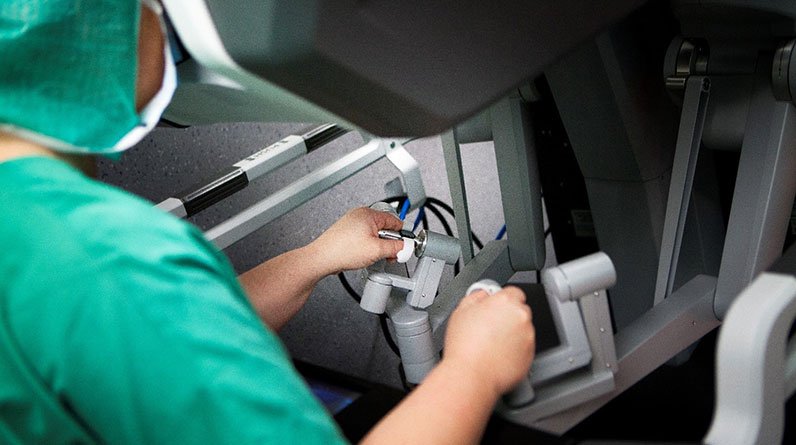
AI in Surgery and Robotics
The convergence of artificial intelligence (AI) and robotic technology stands as a significant achievement that has reshaped the field of surgery.
In what follows, we’ll be discussing the world of AI as it pertains to the realm of surgery, from preoperative planning to intraoperative guidance, AI-driven robotic systems, and its computer vision capabilities.
Artificial Intelligence and Preoperative Planning
Preoperative planning is an important phase in surgical care, involving thorough preparation and assessment of the patient’s condition before the actual procedure.
This phase encompasses a comprehensive review of the patient’s medical history, diagnostic tests, and imaging studies to develop an effective surgical strategy while minimizing potential risks.
In recent years, the integration of artificial intelligence (AI) into preoperative planning has dramatically improved the way surgeons approach this crucial stage. Since surgical care of a patient often needs to be expedited for a multitude of reasons, this AI assistance makes the preoperative process much more efficient and enhances the decision-making process, ultimately improving patient outcomes.
In fact, a recent 2022 study on total knee arthroplasty patients involved a dataset of 5409 manufacturer’s preoperative plans for total knee surgery. In these types of surgeries, the preoperative plan often needs to be adjusted by the orthopedic surgeon during the procedure. This can be undesirable and can cause inefficiencies in the surgical procedure. In the study, AI was used to coordinate the manufacturer’s plan and the surgeon’s operative style and patterns for total knee surgery. When AI was utilized to include all of the data, the preoperative plan was correct 10-15% more often than in cases where AI was not utilized.
Enhancing Decision-making Through Data Analysis
AI technologies, such as machine learning and deep learning algorithms, have the capacity to analyze extremely large amounts of patient data, including patient records, laboratory results, radiological images, and even genetic information.
By processing this extensive data, AI algorithms can identify subtle patterns, correlations, and risk factors that human analysis might miss. This data-driven approach enables surgeons to make more informed decisions, helping them choose the most suitable surgical approach based on the patient’s unique characteristics and medical history.
Predicting Surgical Outcomes
One of the remarkable contributions of AI in preoperative planning is its ability to predict surgical outcomes with a high degree of accuracy.
By learning from historical data of similar cases, AI algorithms can generate predictions about the likelihood of complications, recovery time, and postoperative success, ultimately empowering surgeons to anticipate challenges and plan contingencies in advance, optimizing the surgical strategy and potentially reducing adverse outcomes.
Virtual Surgical Simulations
Finally, AI-driven virtual surgical simulations have emerged as a groundbreaking tool in preoperative planning. Surgeons can now utilize virtual reality environments to simulate the entire surgical procedure before entering the operating room.
These simulations allow surgeons to practice complex maneuvers, refine their techniques, and explore different scenarios in a risk-free setting. By utilizing this knowledge of the intricacies of the surgical procedure, surgeons can enter the operating room with increased confidence and proficiency.
Robotic Surgical Procedures
Robotic surgery has ushered in a new era of precision and innovation in the field of surgery. This cutting-edge approach combines the expertise of skilled surgeons with the precision and flexibility of robotic systems, resulting in enhanced surgical procedures and improved patient outcomes.
Robotic surgical systems consist of advanced robotic arms equipped with surgical instruments and a high-definition camera. These systems are controlled by surgeons from a console in the operating room, where they can manipulate the robotic arms with remarkable dexterity and precision.
This computer-assisted approach overcomes the limitations of traditional laparoscopic or open surgeries by providing a three-dimensional view of the surgical site, as well as eliminating the natural tremors of the surgeon’s hand.
By integrating computer-assisted techniques, robotic surgery has improved various medical specialties, offering a range of benefits that span from increased accuracy to shorter recovery times.
Ultimately, by taking a robotic approach to surgery, many advantages are gained that address and overcome the limitations inherent in traditional laparoscopic surgery. These advantages include enhanced dexterity, enabling the surgeon to undertake technically challenging procedures previously considered difficult or unfeasible.
AI’s Computer Vision Capabilities
Among its many applications, AI’s computer vision capabilities are also a pivotal advancement, leveraging the analysis of vast numbers of images and videos to provide real-time surgical guidance, particularly in laparoscopic and robotic-type surgeries.
AI’s capabilities are particularly impactful in laparoscopic and robotic surgery, where the visualization of the surgical field is often provided through video screens. During these minimally invasive procedures, AI can analyze video feeds in real time and provide guidance directly to the surgical team. By utilizing computer vision algorithms, AI can identify anatomical landmarks, assist in instrument navigation, and even predict potential complications.
AI’s strength goes beyond immediate decision support. Drawing from its analysis of millions of surgical videos, AI can predict upcoming phases of an operation with an impressive degree of accuracy. This remarkable predictive ability even extends to foreseeing the next 15 to 30 seconds of an ongoing surgical procedure.
Final Thoughts
AI’s preoperative planning capabilities and computer vision integrations are redefining the landscape of surgical practice. By leveraging visual data, AI assists surgical teams in real time, offering guidance, predictive insights, and decision support.
As this technology evolves, the synergy between human expertise and AI assistance can potentially elevate the standard of surgical care, ensuring safer, more efficient, and more effective procedures for patients worldwide.
